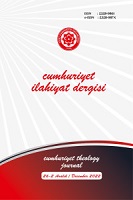Mevlânâ’nın Dîvân-ı Kebîr’inde İktibas ve Telmih Yoluyla Yer Alan Rivayetler
Narrations in Rūmī’s Dīvān-e Kabīr by Way of Quotation or Reference
Author(s): Mustafa YÜCEERSubject(s): Turkish Literature, History of Islam, Theory of Literature, Sociology of Religion, Sociology of Literature
Published by: Cumhuriyet Üniversitesi İlahyat Fakültesi
Keywords: Hadith; Literature; Turkish Poetry; Divān-e Kabīr; Quotation; Reference;
Summary/Abstract: After Turks’ acquaintance with Islam, the interest they showed to religious texts continued in both scientific and literary media. Many thinkers who happened to visit Anatolian lands brought the culture, literature and customs of the geography they lived in and revealed an understanding that we can conceptualize as “Anatolian wisdom (irfān)”. One of those who serve this purpose is undoubtedly Rūmī. Rūmī influenced the geography he lived in with both his conversations and letters, and especially with poetry. In his works he used many texts that he thought belonged to the Prophet Muhammad as hadith. Apart from frequently quoting Qur’anic verses and hadiths, he made references to hadiths especially in the construction of couplets. Whether it is verse or prose, Rūmī, who takes care to act by taking the constants of religion into the center, has shown that this is his method of authorship. The idea of Sufism, which was put forward in a religious sense by Rūmī, who is an authoritative mystic-poet in Turkish-Islamic Literature, and which is based on the principle of tolerance, has been read extensively throughout the ages, and his works have been translated into many languages, especially Turkish, and opened to the access of large masses. The problematic, which also determines the purpose of this study, is the way how such an accepted scholar uses knowledge both ontologically and epistemically. As a matter of fact, the ontological determination of the narrations quoted in the work, rather than the literary and cultural aspects of Dīwān, will reveal the hadith use of Rūmī primarily. In the same way, determining the narrations used with the art of reference and pointing out their place in the main hadith books, comparing them with other works, especially Rūmī’s Mathnawī, will make his hadith sources clear. Although his Mathnawī is much more famous among his works in the course of time and according to widespread acceptance, his Dīwān is also a poetry arranged just like Mathnawī in terms of structure and content. Just as the structure and content forms of Mathnawī were shaped around Qur’anic verses and hadiths, the same style was followed in Dīwān. In this sense, while 475 verses were included with arts of quotation or reference, it was seen that 211 narrations with their repetitions took place in Dīwān-e Kabīr. When the repetitions are removed, the number of narrations in the work is 110. 23 of them are in full, 9 of them are in partial/nāqis quotations and 78 narrations are used by reference. In addition, as a result of our examination, together with the narrations used in the work through reference, couplets that are not directly cited but contain implicit hadiths are also available in Rūmī’s work. In addition to words, parables, proverbs and idioms attributed to previous prophets, important towns, persons and events are also used functionally within the characteristic structure of the work. Within the scope of this study, 110 narrations used by Rūmī, excluding repetitive narrations, were examined. According to the result obtained from takhrīj search, 56 of the narrations in question are found in the main hadith books and are accepted as authentic/sahīh. The judgment of hasan has been given about 6 narrations. Therefore, the total of acceptable/maqbūl narrations in the work reaches 62. One of the acceptable/maqbūl narrations is a mawqūf hadith. In addition to 44 narrations, which are not included in the basic hadith books and are judged to be weak/da'īf, fabricated/mawdū‘ or false, there are 4 texts that are not hadith but belong to one of the predecessors/salaf, and there are 48 rejected/mardūd narrations. Considering distribution of the narrations used by Rūmī, texts on the relationship between Allah and the servant were preferred, and the narrations on moral issues were also used intensively. In addition, the texts containing the propositions about the prophet and religion were also preferred by him. Apart from this, matters of faith and worship; narrations about women, social life and medicine are some of the prominent topics. It should be noted here that Rūmī does not have any concerns about the authenticity of the hadiths, both in his choice of narrations and in the process of converting them into quotation or reference form. This result can be easily obtained when the acceptable narrations used in Dīwān are evaluated together with the weak/da'īf or fabricated/mawdū‘ narrations. Because the author’s view of the narration, which is considered weak/ da'īf or fabricated/mawdū‘, and the view of the narration, which is accepted as authentic, are shaped according to the correspondence of the message to be given and the meaning of the narration. In other words, according to him, contribution of the content of the text to the message is more important than the soundness of the hadiths. In addition, mystical thoughts and teachings that shaped the mental world of Rūmī are also evident in his choice of the narrations in question.
Journal: Cumhuriyet İlahiyat Dergisi
- Issue Year: 26/2022
- Issue No: 2
- Page Range: 491-512
- Page Count: 22
- Language: Turkish

